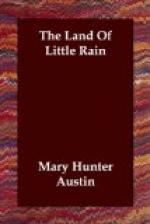Before Seyavi made baskets for the satisfaction of desire,—for that is a house-bred theory of art that makes anything more of it,—she danced and dressed her hair. In those days, when the spring was at flood and the blood pricked to the mating fever, the maids chose their flowers, wreathed themselves, and danced in the twilights, young desire crying out to young desire. They sang what the heart prompted, what the flower expressed, what boded in the mating weather.
“And what flower did you wear, Seyavi?”
“I, ah,—the white flower of twining (clematis), on my body and my hair, and so I sang:—
“I am the white
flower of twining,
Little white flower
by the river,
Oh, flower that twines
close by the river;
Oh, trembling flower!
So trembles the maiden
heart.”
So sang Seyavi of the campoodie before she made baskets, and in her later days laid her arms upon her knees and laughed in them at the recollection. But it was not often she would say so much, never understanding the keen hunger I had for bits of lore and the “fool talk” of her people. She had fed her young son with meadowlarks’ tongues, to make him quick of speech; but in late years was loath to admit it, though she had come through the period of unfaith in the lore of the clan with a fine appreciation of its beauty and significance.
“What good will your dead get, Seyavi, of the baskets you burn?” said I, coveting them for my own collection.
Thus Seyavi, “As much good as yours of the flowers you strew.”
Oppapago looks on Waban, and Waban on Coso and the Bitter Lake, and the campoodie looks on these three; and more, it sees the beginning of winds along the foot of Coso, the gathering of clouds behind the high ridges, the spring flush, the soft spread of wild almond bloom on the mesa. These first, you understand, are the Paiute’s walls, the other his furnishings. Not the wattled hut is his home, but the land, the winds, the hill front, the stream.




